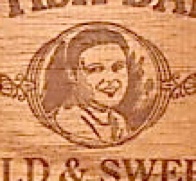Babe Ruth Cigar Box Fraud
It’s a Babe, but not a Ruth
A National Cigar Museum Expose´
© Tony Hyman

Babe Ruth Cigar Box Fraud
It’s a Babe, but not a Ruth
A National Cigar Museum Expose´
© Tony Hyman
This 1930s boite nature box of 50 has been offered on ebay a dozen times, ten of those times by dealers incorrectly identifying her as Babe Ruth.
BOYISH BABE BOX
This box has been misidentified by sports dealers and auctioneers for decades. Whether this is the result of ignorance about “Boyish Babe” Didrickson or a deliberate effort to greedily jack up the value is unknown. The ugly truth is that Babe Ruth is marketable, Babe Zaharias is not. A quick sloppy identification is profitable.
The cigars in these boxes were made under contract in at least two different factories, including one in her adopted home town of Tampa, a city where she designed, built and owned two golf courses. BOYISH BABE is a fine boite nature box honoring a great champion worthy to be included in any sports exhibit.
But know whom you’re displaying.
Even if you don’t own this box, Google her and read about her amazing sports accomplishments and see why she deserves being featured. There’s plenty posted.
Babe Didrickson Zaharias
At the 1932 Olympic trials, the 20 year old Mildred Ella “Babe” Didrickson announced “I came here to beat everybody in sight and that’s just what I’m going to do.” She kept her word, winning six gold medals and breaking four world records, single handedly defeating the second-place Illinois Athletic Club, which had twenty-two members. At 21, she went on to win two golds and a silver in track and field at the Berlin Olympics.

Brash and always outspoken, she loved the media and the media loved her. Babe was always good for a story or photo.
A sports writer reportedly asked her “I’m told you also swim, shoot, ride, row, box, and play tennis, golf, basketball, football, polo and billiards. Is there anything at all you don’t play?” “Yeah,” she allegedly replied, “dolls.”
The 1930’s, 40’s and 50’s weren’t the best decades to respond with such an unfeminine answer. Especially if you were a not particularly attractive androgynous-dressing makeup-less woman jock. Questions began to surface about her sexuality (or lack of it) in a day when being lesbian was a lot less acceptable than today. She was hurt deeply when one journalist wrote that despite her exploits she “cannot compete with other girls in the very ancient and honored sport of man trapping.” Babe was grateful for the assessment of Associated Press who responded by calling her a “normal, healthy, boyish looking girl.”
Didrickson thereafter specifically asked writers to refer to her as “boyish” rather than masculine, and in the late 1930’s began, with the help of a friend, a campaign to feminize her image. Although she kept her hair short for practical reasons, she began wearing dresses (even a girdle), hats, nail polish, lipstick and other makeup, and regularly began wearing pearls. She also married, choosing wealthy multi-year world champion wrestler George Zaharias who quit his career and became her manager.
Her last move to feminize her image involved sports. She loved the fame and attention too much to give up athletic competition, but bowed to the popular conception that “real women” should only be involved in four sports: swimming, tennis, ice-skating or golf. Mrs. Zaharias chose golf. With a vengeance. A power-driver she revolutionized the way women’s golf was played and in 1948 brought money into the game by founding the LPGA. She went on to win 82 tournaments, at one point 14 in a row (some reports say 13; always exaggerating she claimed 17). An early proponent of the psychological advantage of trash-talking, she did not endear herself to other golfers by frequently entering the locker room and loudly announcing that the assembled ladies would be “playing to see who’ll come in second?” Fans loved her.
A medal-winner and sports champion, Babe deserves a great deal of credit for opening professional golf to women, and inspiring a generation of women to break traditional roles. Babe Didrickson Zaharias died young, at age 45, of colon cancer.
Despite claims of auctioneers and ebay sellers, this box has nothing to do with Babe Ruth. It pictures a babe, but it’s Babe Didrickson Zaharias, founder of the LPGA, generally regarded as the greatest female athlete in history.


